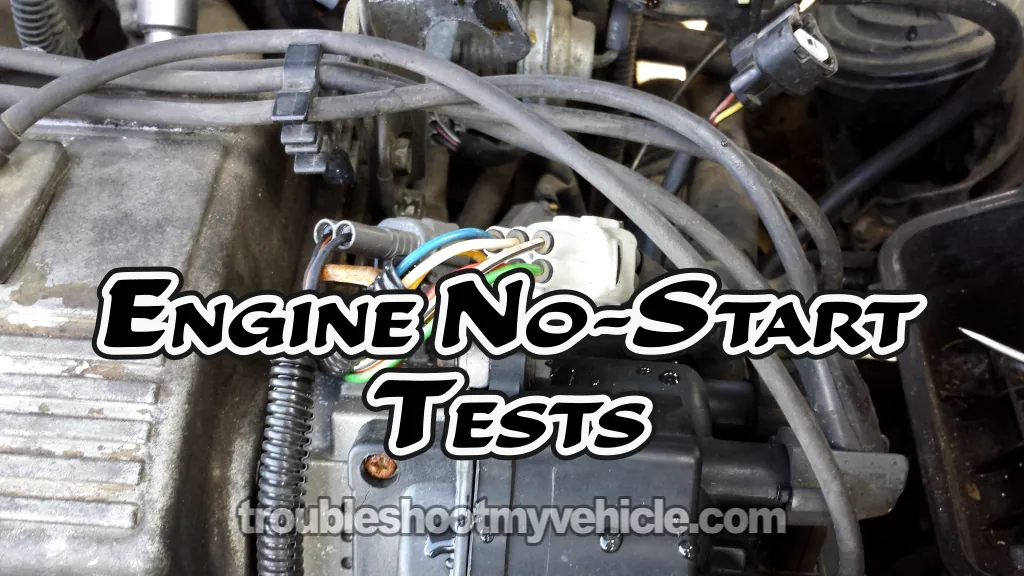
Trying to figure out why your engine won't start (especially if you've never done it before) can feel like hitting a brick wall.
I've looked into tons of no-start problems over the years. In this guide, I'm gonna show you how I track down the usual suspects that might be stopping your 1993–1997 1.8L 7A-FE Toyota Corolla from turning over.
This method keeps you from wasting time swapping out parts that aren't the issue. You'll dodge some headaches, hang on to your cash, and get back on the road faster.
I'm also linking to all the step-by-step guides you'll need to test each part and figure out exactly what's keeping the engine from starting up.
Contents of this tutorial:
APPLIES TO: This tutorial applies to the following vehicles:
- 1.8L (7A-FE) Toyota Corolla: 1993, 1994, 1995, 1996, 1997.
- 1.8L (7A-FE) Geo Prizm: 1993, 1994, 1995, 1996, 1997.
Difference Between A No-Start And A No-Crank Condition
Before we jump into how to figure out why the engine won't start, you gotta know the difference between an engine no-start and an engine no-crank problem.
Once you get what sets these two apart, it gets way easier to nail down what's wrong with your car.
In a nutshell:
- Engine No-Start: The engine turns over, but it just won't fire up. That usually means there's something off with the ignition system, fuel delivery, or maybe something mechanical inside the engine.
- Engine No-Crank: Nothing happens when you turn the key—the engine doesn't even try. This one's usually caused by a dead battery or a busted starter motor.
If your Corolla won't crank at all, start by testing the battery and checking if the starter motor's doing its job.
Engine No-Start Diagnostic Basics
When you're trying to figure out why your Corolla won't start, keep in mind the engine needs three basic things to run:
- Air (through compression)
- Fuel
- Spark
If even one of those is missing, the engine's gonna turn over, but it won't fire up.
For a 1993–1997 1.8L Toyota Corolla, most no-start problems usually come from one of these areas:
Ignition system issues:
- Bad ignition parts: Think ignition coil, igniter (aka ignition control module), spark plug wires, or stuff inside the distributor like a worn cap, rotor, or pickup coil.
- If any of those quit on you, you'll get no spark —so the engine will crank, but it won't start.
Fuel system issues:
- Fuel pump failure: When the fuel pump dies, no gas reaches the engine. So yeah, it'll crank all day, but it's not gonna start.
Mechanical problems inside the engine:
- Blown head gasket: This messes with compression, can make the engine overheat, and can keep it from starting.
- Snapped timing belt: If the timing belt breaks, the camshaft and crankshaft stop working together. Pistons and valves go out of sync, and your engine just won't run.
- Low compression: Usually caused by worn-out piston rings, busted valves, or heavy internal damage like a thrown rod. If more than two cylinders lose compression, the engine won't suck in air or compress the fuel-air mix —so it's gonna crank but not fire up.
How Can I Troubleshoot A No-Start Problem?
Figuring out why your engine won't start is really just a process of ruling things out one by one.
Start by checking if all four cylinders are getting spark. That's always my first move because most no-start problems come from the ignition system.
If the ignition checks out, go down the list and test the usual suspects. Each test either confirms the issue or clears that part so you can move on.
Here's how I tackle engine no-start problems:
- Kick things off with the ignition system:
- Check for spark at all four cylinders first.
- Use a spark tester on each plug wire while cranking the engine to get accurate results.
- These guides walk you through the ignition tests:
- If all four cylinders are getting spark, then the ignition system's doing its job. Next, make sure fuel's getting to the engine.
- Check the fuel pump pressure:
- Once the ignition system checks out, see if the pump inside the tank is pushing fuel to the injectors.
- A fuel pressure gauge will tell you if the pump's working.
- You can also spray some starting fluid into the throttle body. If the engine fires up briefly, it's likely a fuel delivery issue.
- This tutorial shows you how to check both:
- If you've got spark and fuel, then it's time to look at the engine's mechanical health.
- Look for a blown head gasket:
- Once spark and fuel are confirmed, this is the first engine-related test I recommend running.
- You can check for a blown head gasket in four different ways. Two of them are quick and don't need tools.
- If the engine overheated recently or even in the past, you definitely wanna run this test.
- This tutorial shows you all four methods:
- Test engine compression:
- Grab a compression gauge and check if each cylinder's building enough pressure to run the engine.
- This tells you whether the cylinders are doing their job.
- If compression's bad, you'll usually see:
- All or most cylinders showing low pressure (under 100 PSI) or no pressure at all.
- Any cylinder with little to no compression won't ignite the air-fuel mix, which means it's not helping the engine start.
- This guide shows you how to do the test and read the results:
- Take a look at the timing belt:
- Timing belts should be replaced around every 60,000 to 80,000 miles. If it isn't done, it's only a matter of time before it snaps —and when that happens, your engine's not starting.
- There are a few ways to check if the belt broke. This guide walks you through it:
Bottom line? Solving a no-start problem just means testing one system at a time. Start simple, follow each step, and you'll find what's missing.
When you test each part one at a time, you'll quickly figure out what's working and what's not.
If a part checks out, just move on to the next one until you land on the problem. This step-by-step method keeps things simple, saves you time and money, and helps you avoid replacing parts that aren't broken on your Toyota.
Tools You'll Need to Troubleshoot An Engine That Won't Start
Having the right tools makes all the difference when you're trying to track down a no-start issue. Without them, you're just guessing —and that's gonna eat up your time, your wallet, and your patience.
Everything in the list below plays a key role in figuring out whether the problem's electrical, fuel-related, or something mechanical like low compression.
- Multimeter:
- Shows if parts are getting power and Ground. You'll also use it to check things like the ignition coil, pickup coil inside the distributor, and wiring connections.
- Don't have a multimeter? Check this one out —it's the same one I use: Tekpower TP8268 AC/DC Auto/Manual Range Digital Multimeter with NCV Feature (at: amazon.com).
- Spark Tester:
- The best tool for checking if there's spark is a spark tester.
- Here's the one I use and suggest: OTC 6589 Electronic Ignition Spark Tester (at: amazon.com).
- Fuel Pressure Test Gauge:
- Checks fuel pressure to make sure the fuel pump and regulator are working like they should.
- Compression Test Gauge:
- Tests compression in each cylinder to confirm the engine's building enough pressure for combustion.
- Here's the one I use and recommend: Actron CP7827 Compression Tester Kit (at: amazon.com).
- Chemical Combustion Leak Detector:
- Lets you spot combustion gases in the cooling system —a clear sign the head gasket is blown.
- Basic Hand Tools:
- You'll need these to remove stuff like spark plugs, fuel lines, or the distributor cap while you're checking things out.
- This means sockets, wrenches, screwdrivers, and pliers —everything you'll need to reach and test different engine parts.
More 1.8L Toyota Corolla Tutorials
You can find a complete list of 1.8L Toyota Corolla tutorials and wiring diagrams in this index:
Here's a sample of the tutorials you'll find there:
- How To Test The Fuel Injectors (1993-1997 1.8L Toyota Corolla).
- How To Test The Throttle Position Sensor (1993-1997 1.8L Toyota Corolla).
- How To Do A Cylinder Balance Test (1993-1997 1.8L Toyota Corolla).
- How To Test The Intake Air Temp (IAT) Sensor (1993-1997 1.8L Toyota Corolla).

If this info saved the day, buy me a beer!

